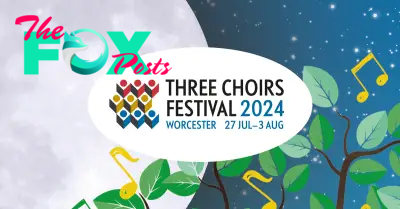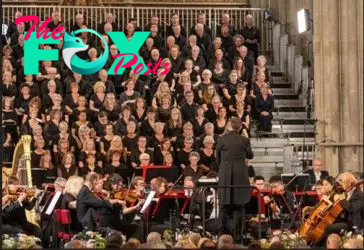Entertainment
The UK premiere of Snider’s Mass for the Endangered on the Three Choirs Pageant – Seen and Heard Worldwide

 United Kingdom Three Choirs Pageant [3] – Biles-Liddell, Weir, Elgar, Snider: Three Choirs Pageant Refrain, Philharmonia Orchestra / Samuel Hudson (conductor). Worcester Cathedral, 29.7.2024. (JQ)
United Kingdom Three Choirs Pageant [3] – Biles-Liddell, Weir, Elgar, Snider: Three Choirs Pageant Refrain, Philharmonia Orchestra / Samuel Hudson (conductor). Worcester Cathedral, 29.7.2024. (JQ)

Cameron Biles-Liddell – Yr Afon Yn Yr Awyr (2022)
Judith Weir – O Candy Spontaneous Earth (2021)
Elgar – Serenade for Strings, Op.20 (1892)
Sarah Kirkland Snider Mass for the Endangered (2018)
This Three Choirs Pageant live performance supplied an eclectic vary of items. Aside from the Elgar Serenade, I had by no means heard any of the works involved, so I took my seat in Worcester Cathedral with a way of anticipation.
Samual Hudson started with a brief work (about 12 minutes) for orchestra by the younger Welsh composer, Cameron Biles-Liddell. He’s primarily based in North Wales and I discovered from his web site that his music ‘attracts considerably from the pure landscapes, points of momentum, in addition to conveying his personal Welsh heritage and folklore by music’. The work we heard, Yr Afon Yn Yr Awyr (The River within the Sky) was premiered in Wales in November 2022 and was receiving its first efficiency in England. The composer describes the work as ‘a set of three interrelated actions impressed by the nickname given to the aqueduct primarily based in Pontcysyllte, North Wales. In essence, I wished to discover how I might musically create a way of floating by stasis and movement, very similar to the water within the aqueduct flowing above the River Dee. As such, every motion flows straight into the following, exploring a specific side of the imagery of a River in The Sky. What connects the person actions is the melodic line that subtly weaves it manner by totally different contexts and moods representing how the river in flows from Pontcysyllte by North Wales and past’. Yr Afon Yn Yr Awyr is scored for fairly modest forces comprising single woodwind, horn, trumPet, trombone, percussion (1 participant), harp and strings.
I actually warmed to this piece. Within the first of the three actions the music is energetic and energetic. Underneath Hudson’s route, the Philharmonia performed it with crisp assault. There’s a lot occurring on this music – dare I threat a watery pun by saying each on and below the floor? Nevertheless, this exercise, and specifically the rhythmic vitality, is rarely only for its personal sake. Seamlessly, Biles-Liddell moved into the central sluggish motion, which is the guts of the work. The music is sluggish and considerably mysterious in nature. I should have been in punning temper as a result of I scribbled in my notes ‘nonetheless waters run deep’. I believed this was very imaginative and evocative music. It achieved a quick, highly effective climax, however for essentially the most half the temper was tranquil. Fittingly for a Welsh composer, Biles-Liddell deployed the harp prominently and to evocative impact because the motion neared its shut. The ultimate motion evoked once more the daytime power of the river. Because the piece moved in the direction of its conclusion the music turned dynamic and quick; the river was in full spate. Yr Afon Yn Yr Awyr is a assured, enticing and creative rating which Hudson and the Philharmonia performed very nicely certainly. I loved it very a lot and to evaluate from the nice and cozy reception given to the composer, who was current, so did the remainder of the viewers.
Additionally current was Dame Judith Weir, whose seventieth birthday is being marked by the Pageant this week with the efficiency of a number of works. Tonight, we heard a reasonably latest piece for refrain and string orchestra, O Candy Spontaneous Earth. On this work, which performs for about quarter-hour, Weir set three poems by American poets; every poem, she says, ‘is concerning the Earth, and our expertise of residing on it’. I’ve admired lots of Weir’s items up to now however I struggled considerably with this one. I feel partly this was as a result of the work opens with a setting of a poem O candy spontaneous by E. E. Cummings (1894-1962). I’ve by no means been in a position to perceive Cummings’s poetry – the fault is mine, I’m certain – and so I discover it laborious to understand musical settings of his verse. Weir says that the poem ‘talks concerning the Earth’s persevering efforts to regenerate itself regardless of the depredations of its inhabitants’; I’ve to say that wasn’t apparent to me from studying it. Weir’s setting of the poem is purposeful and was strongly projected by the Pageant Refrain. The longest motion is a setting of Peace on Earth by William Carlos Williams (1883-1963); this ‘speaks of the magnificent constellations of stars shining within the sky above us whereas we sleep peacefully’. There was heat within the music for the choir; their singing of every stanza was punctuated by fascinating orchestral interludes. Lastly, got here I motive, Earth is brief by Emily Dickinson (1830-1886). On this poem of three stanzas, Dickinson ‘ponders the quick time we really spend on Earth, and what occurs afterwards’. Weir set these phrases as a sort of chorale which grew in energy because the motion unfolded till, by the third stanza, the tone was genuinely uplifting. Different works by Weir have stirred me extra up to now than O Candy Spontaneous Earth. Nevertheless, her piece acquired a dedicated, excellent efficiency from the Pageant Refrain.

We have been on rather more acquainted territory with Elgar’s Serenade for Strings. The piece was performed by a modest-sized string orchestra (6/6/4/3/2, I feel) and the dimensions of the ensemble produced big advantages by way of readability. The primary motion, ideally paced by Hudson, flowed very well; there was a pleasant spring within the rhythms. The ultimate motion, too, was fashionable and extrovert. It’s the central sluggish motion, although, which lies on the coronary heart of the Serenade. The efficiency was stunning; the enjoying had heat and affection. This can be a reasonably early work, courting from a number of years earlier than the mastery of ‘Enigma’ and Gerontius, however that is quintessential Elgar. It was testomony to the excellence of this efficiency that in it you may have heard a pin drop. This was an excellent efficiency of the Serenade; certainly, it was the best efficiency of something that I’ve heard up to now this week.
After the interval got here the signature work of the night, one which was presumably chosen as a result of its idea and design fitted with one of many essential themes of this yr’s Pageant; within the phrases of Creative Director Samuel Hudson, ‘the pure world, at a time when the problem of preserving and defending our planet is related to us all’. We heard the UK premiere of Mass for the Endangered by the American composer, Sarah Kirkland Snider (b.1973). On this work, Snider mixed the textual content of the Latin Mass with poetry by her fellow American, Nathaniel Bellows who’s a author, visible artist, and musician. Kirkland described Bellows’ phrases as ‘unique’; I’m not certain if meaning they have been written particularly for this challenge however that might be the case. The composer stated this about her work: ‘Mass for the Endangered embodies a prayer for endangered Animals and the imperiled [sic] environments during which they stay… [it] appeals for parity, compassion, and safety, from a mindset — a malignance or apathy — that threatens to destroy the planet all of us are supposed to share.
This can be a substantial work and lasted some 50 minutes. It was conceived for SATB refrain and twelve devices, comprising single strings, 4 woodwinds, percussion (1 participant), piano and harp. For this efficiency, nevertheless, the string part had been elevated – I feel the identical variety of Gamers took half as within the Elgar – although I couldn’t make certain if the woodwind part had been expanded; I feel not. This enlargement of the instrumental forces adopted the precedent set with Josph Fort’s decreased scoring of Holst’s The Cloud Messenger (overview right here) and I think it was finished for a similar pragmatic causes. Nevertheless, on this event I’m not certain that the concept labored as efficiently.
Snider begins with a Kyrie which mixes ‘Kyrie eleison’ with phrases by Bellows. The music opens quietly however it’s not lengthy earlier than there’s rising urgency. Right here, and elsewhere within the piece, I couldn’t all the time discern the phrases clearly, regardless that my seat was fairly close to the entrance; since readability of diction isn’t often a problem with the Pageant Refrain, this can be a query of the character of Snider’s vocal writing. I jotted down the phrases ‘music of contrition’ in my notes. This was a robust opening to Mass for the Endangered. The top was significantly efficient; the sopranos held a word for an awfully very long time whereas the orchestral accompaniment step by step light into quiet fragments. Within the Gloria there are not any modern phrases; Snider units solely the normal Latin textual content. Her method to the Gloria is most uncommon and unique. Her music isn’t a traditional hymn of reward; as an alternative, the setting opens with an prolonged, quiet passage for sopranos (finally joined by the altos, I feel), accompanied simply by the harp. The harp half is fiercely impartial of the vocal line and, in fact, appears to supply no assist to the singers (that’s only a assertion of truth, not a criticism). The vocal traces are lengthy and carolling. It appeared to me that right here Snider conveys not a lot reward as a way of surprise. Ultimately, the complete choir is deployed, and the remainder of the orchestra, however their involvement is pretty temporary; Snider then returns to the feminine voices and harp to finish the Gloria quietly. This can be a most fascinating and unique motion
The third motion. ‘Alleluia’ units phrases by Bellows. Male voices are outstanding on this motion, singing towards orchestral writing that’s relatively jagged in nature. I discovered it laborious to discern the phrases, maybe as a result of the lads have been positioned on the rear of the choir. To be sincere, I didn’t get pleasure from this motion very a lot. If the Gloria used no modern phrases, virtually the reverse is true within the Credo. Right here, virtually all of the textual content is supplied by Bellows, although a fraction of the Credo textual content (typically in Latin, typically in English) seems on occasion. This fragment was, I feel, schematically essential as a result of it was primarily based on the phrases ‘Et expecto’. I worry that this motion was the purpose within the work the place I parted firm with Snider. It’s an in depth motion, setting a considerable textual content by Bellows. His phrases, to be frank, are a litany of environmental and social justice aspirations. I don’t assume anybody would critically argue with the concepts expressed by Bellows; I definitely wouldn’t. The issue is that there are far too many factors made within the textual content and Snider units the phrases to loud, emphatic music; that’s comprehensible, as she certainly wished to stress the significance of the emotions. Nevertheless, nicely earlier than the motion’s finish I felt I had been hit over the top; this was certainly a case the place much less would have meant rather more. This was additionally the purpose once I felt that the choice to develop Snider’s scoring was misjudged. Within the Holst piece the earlier night time it labored nicely as a result of Holst’s scoring is so typically delicate. Against this, Snider’s instrumental writing – for the strings specifically – is far stronger in profile (once more, an announcement of truth, not a criticism) and the orchestra relatively overwhelmed the singers at instances, although the Pageant Refrain supplied energised, strongly dedicated singing.
Within the Sanctus/Benedictus motion, Snider set solely the phrases from the Mass. There was a lot joyful-sounding writing for the choir and the music typically had a lighter contact, which was a welcome distinction after the Credo. Within the Benedictus specifically there have been a variety of quick solo passages, taken by members of the Pageant Refrain. The person singers have been valiant although it appeared to me that the writing typically put them below pressure. A solo voice – a beautiful soprano line, very nicely sung – was heard in the beginning of the ultimate motion, the Agnus Dei. Right here, a lot of the textual content was by Bellows and Snider set his phrases to music that grew in depth, although there have been additionally lyrical passages; the alternation between lyricism and depth labored nicely. Snider introduced the work to an in depth in a temper of uneasy quiet, reflecting the apprehension we should all really feel for the state of our world and its future.
I actually wished to love Mass for the Endangered not least as a result of it addresses essential points. It contains some good and persuasive passages. Nevertheless, I felt that there was fairly a level of overkill at instances within the modern textual content and the way in which that Snider set these phrases. The model of the music got here as a little bit of a shock. Snider’s biography contains press quotes about her music describing it as ‘rapturous’ and ‘ravishingly stunning’. There was little of that obvious to me in Mass for the Endangered although I readily acknowledge that I used to be listening to it for the very first time. The music struck me as a lot grittier than these press quotes advised; maybe, although, that displays the seriousness and urgency with which Snider views the problems which are confronted in her Mass.
The standard of the efficiency appeared to me to be excessive; Hudson clearly believes within the rating and performed it urgently. The viewers responded generously to the efficiency. I’m certain it’s an essential rating but it surely didn’t transfer me as I had hoped it will. There’s a recording of the work on the Nonesuch label, which I’ve not heard; it’s by the ensemble Gallicantus performed by Gabriel Crouch. I think that makes use of the composer’s unique scoring; maybe I ought to give Mass for the Endangered one other attempt.
John Quinn
-

 Entertainment3h ago
Entertainment3h agoMike and Lauren Sorrentino Introduce Baby No. 3 to Kids in ‘Jersey Shore’ Exclusive Clip
-

 Entertainment6h ago
Entertainment6h agoNatasha Rothwell on Her Memorable Firsts
-

 Entertainment11h ago
Entertainment11h agoFace Me and Other Korean Medical Crime Shows That are Must Watch
-

 Entertainment17h ago
Entertainment17h agoClassic Korean Movies Like Piagol to Add to Your Watch List
-

 Entertainment17h ago
Entertainment17h agoOver 60 Million People Tuned in to Watch Jake Paul vs. Mike Tyson
-

 Entertainment1d ago
Entertainment1d agoPopular Hudson Valley Italian Restaurant Addresses Closing Rumors
-

 Entertainment1d ago
Entertainment1d agoRHOBH’s Dorit Kemsley Addresses Viral Smoking Scene on Season 14 Premiere: ‘I Was Being Chased’
-

 Entertainment1d ago
Entertainment1d agoThe 10 Best Podcasts of 2024

















